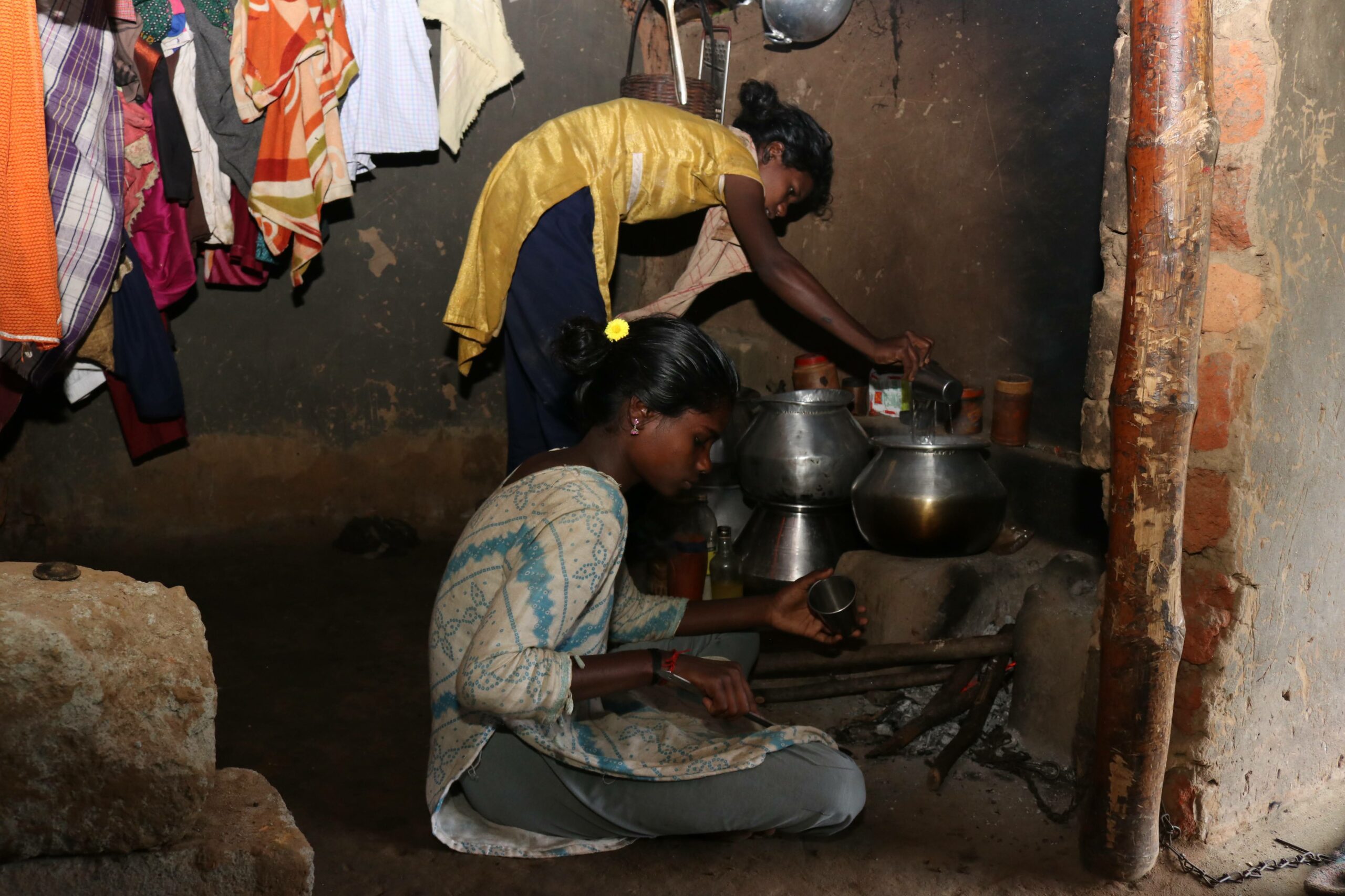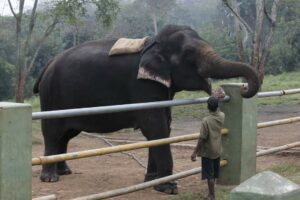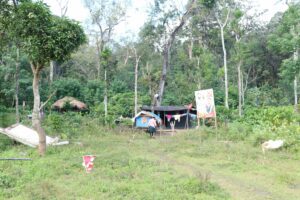A faulty relocation drive and climate change are threatening the survival of Kattunayakars living in the Nilgiri Biosphere Reserve.

Kattunayaka sisters cooking in their hut at Chettiyalathur forest village in Wayanad. (KA Shaji/ South First)
“Naan vannu Kaadunaayagan” (I am a Kattunayakan), Bomman introduces himself as the camera pans the verdant Mudumalai Tiger Reserve in Tamil Nadu’s Nilgiris district.
The documentary, The Elephant Whisperers, begins with Bomman’s introduction. “Kaadunayagan enbathle kaadukku dhithavan” (Kaattunayakan means the king of the forest), he explains nonchalantly in a mix of Dravidian languages.
The indigenous tribespeople living in the margins of society and forests hogged the limelight after the Karthiki Gonsalves-directed The Elephant Whisperers won the Oscar for Best Documentary Short Film at the 95th Academy Awards.
Despite the documentary drawing attention to Kattunayakars, as they are collectively called, the hunter-gatherer tribespeople are facing an existential crisis.
Numbering about 72,000, these tribespeople are spread over the Nilgiri Biosphere Reserve (NBR), the trijunction of the Mudumalai Tiger Reserve, Bandipur and Nagerhole Tiger Reserves of Karnataka, and the Wayanad Wildlife Sanctuary in Kerala.
Traditionally forest dwellers, the Kattunayakars seldom mixed with other tribal communities. They eke out a living by collecting and selling honey, wax, and other minor forest products (MFPs).
Though hunting was part of their existence, stringent forest laws enacted in 1865 and 1878, made the government the single stakeholder of forests, which marked the beginning of the alienation of tribespeople with the land they have been living on for generations.
Further, the subaltern forest-dependent communities are under the constant watch of the Forest Departments of the three states.
Bomman tells about the community’s umbilical link with the forests: “Naan kaadula iddhu, thinnu, dhabbaiye Vrindavan” (I was born, raised, and been living in the forest).

A Kattunayakan tribesman feeding a captive elephant at Theppacaud Elephant Camp in Mudumalai. (KA Shaji/ South First)
The Elephant Whisperers is about Kattunayaka couple Bomman and Bellie’s bond with an orphaned elephant calf, Raghu, and the tribe’s reverence towards the forest.
Climate change and deforestation have affected the availability of honey in the forests, and Forest Department officials have imposed restrictions on collecting MFPs.
Additionally, forest dwellers are now facing a massive relocation drive, meant to leave the forests exclusive to wild animals.
Most Kattunayakars refused to shift and rejected the Central government-sponsored rehabilitation package of ₹10 lakh per family.
Those who accepted the offer are now facing the after-effects of a poorly conceptualised programme. They now feel displaced and misplaced.
They have to travel 30-40 km from their new location to reach the forests and engage in the only profession they know.
In Mudumalai, 20,000 tribespeople, mostly Kattunaykars, are facing relocation. In Wayanad, the number is 7,000.
“After the documentary won the Academy Award, there is a steady rush to Muthumalai to see Bomman, Bellie, and other Kattunayakars the Tamil Nadu Forest Department has employed to look after elephants,” said Ravi Masthi, a Kattunayakan living at the Vadakkanad Tribal Settlement near Sulthan Bathery in Wayanad.

A hut belonging to a Kattunayaka family at Chettiyalathur forest village in Wayanad. The family is facing the threat of getting relocated. (KA Shaji/South First)
“The century-old Theppakadu Elephant Camp in Mudumalai has given employment to many Kattunayakars as elephant trainers and tamers. The same applies to Muthanga and Tholpetty eco-tourism spots in Wayanad and Nagerhole-Bandipur forests, where elephant safaris constitute an important part of eco-tourism,” he told South First.
“However, as a community, we have fallen victim to the discriminatory relocation programmes, and the climate change-induced depletion in forest produces,” he added.
For generations, Ravi’s family had been living deep inside the Kurichiat forests in the Wayanad Wildlife Sanctuary.
The Forest Department forced them to accept the compensation package and relocate to Vadakkanad.
Ravi said the compensation was not enough to purchase land in a decent locality. He now has five cents of land in a remote corner of Vadakkanad, and he travels to Kurichiat to gather honey.
While 49 families from Kurichiat were relocated in the past decade, seven families from nearby Chettiyalathur forest village, too, have been shifted.
Along with Kattunayakars, bonded-labour tribal community Paniyas and small-scale agriculturists Wayanadan Chettis, too, face the threat of relocation.
While those who support the relocation drive promote success stories of eco-restoration, Kattunayakars find it a move that weakens the Forest Rights Act and deprives them of their traditional livelihood and resources.
Several others, who were forced to shift, have stopped gathering honey and collecting MFPs. They are now working as farmhands.
“The relocation began first in Mudumalai and its surroundings two decades ago. It is now being extended to Wayanad and Karnataka forests. This is a move to finish off the Kattunayakan community, who were once the kings of the Western Ghats forests,” said MS Selvaraj of the Vivasayigal Thozhilalargal Munnetra Sangam (Farmers and Workers Progressive Front) of Gudalur, a Tamil Nadu area bordering the Mudumalai Tiger Reserve.
“As the Oscar-winning documentary asserts, these people are known for their harmonious coexistence with nature. It would be difficult to find any poaching case against any Kattunayakan. They are not just being relocated from their forests but are also denied their dwelling and livelihood rights guaranteed under the Forest Rights Act,” he told South First.
Among the NBR tribespeople, Kurumbas, Sholigas, and Irulas are known to be the primary honey hunters, along with Kattunayakans — the largest among these communities.
The threat to Kattunayakars began in the 20th century when settlers from the plains of Kerala and Tamil Nadu migrated to the forests, seeking greener pastures.
They changed the land-use patterns, and consequently, the forest cover dwindled.
Invasive species planted by Forest Departments to add beauty to the reserves and sanctuaries affected the natural biodiversity of the forests.
As a result, human-animal conflicts are rising in the NBR, and the Kattunayakars bear the brunt. Climate change has severely affected the availability of tuber crops and fruits.
“Unlike in the past, honey is fetching higher prices in the markets outside. Some forest officials also tell us that increasing heat forces bees to generate more honey. But, we are facing a shortage of honey,” said Raju Bomman, a Kattunayakan from Muthanga in Wayanad.
“It’s a fact that traditional forest dwellers protected the forests more than the Forest Department. However, the authorities are now treating Kattunayakars on a par with those from outside regarding relocation and occupation of forest lands,” said Coimbatore-based rights activist CR Bijoy.
“We need to protect their legal rights, and conservation is possible only with their involvement,” he told South First.
Kattunayakars are strongly rooted in their culture and worship nature, besides their ancestors. They are physically strong enough to scale steep cliffs or tall trees to collect honey.
Outside the NBR, the Kattunayakan community is found in the forests of the Kozhikode and Malappuram districts of Kerala.
Fragmentation of forests, commercial tea and eucalyptus grandis plantations, and uncertain weather patterns are also threatening these indigenous honey harvesters.

A Kattunayakan boy at Chettiyalathur. Besides houses, authorities offered education to the children of relocating families. (KA Shaji/ South First)
According to Kattunayaka elders like P Velayudhan of Pandalur in Nilgiris, honey played an important part in their lives. It was their food, medicine, and major source of livelihood. They face only one enemy while searching for honey: Bears.
Across states, these people are listed among the Particularly Vulnerable Tribal Groups (PVTGs). Raju Bomman said his tribe has been lured into accepting the rehabilitation offer, promising houses, education for their children, and job opportunities for the youths.
But more than a decade after relocating, they are still living in tin-roofed houses with no access to forests and any sustainable source of income.
The literacy rate is low among Kattunayakars, and they practise traditional medicine. Still, most prefer to live without modern amenities like power and water connections.
“The governments are calling it a voluntary relocation project. But in practice, it involves coercion. It violates all existing legislation, including the Forest Rights Act, 2006. I hope that the Oscar-winning documentary will force the authorities to take a serious look at their struggle to survive,” Divya Kalathingal, a teaching faculty with Sri Sankara University in Kerala, who researched the topic of tribal relocation from forests, told South First.
Meanwhile, as The Elephant Whisperers reveals, Raghu and Ammu, the two calves that Bomman and Bellieyamma reared as their children, were taken away against their wishes, and handed over to other caregivers.
The Oscar has, indirectly, put more restrictions on the couple, with the authorities prohibiting them from talking to the media without the permission from the “top”, reports said.

Jul 26, 2024

Jul 26, 2024

Jul 25, 2024

Jul 25, 2024

Jul 25, 2024

Jul 24, 2024